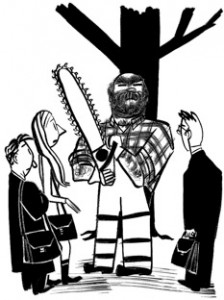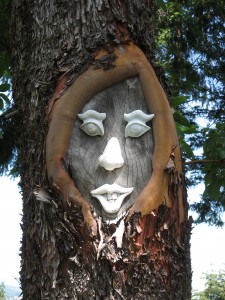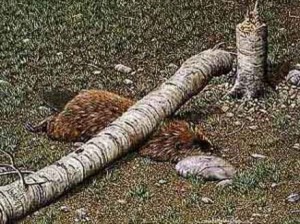PRUNING GUIDELINES After working over some dogwood trees I was going to write to that topic. As the season progressed I saw a greater need to write about general pruning. Most importantly I would caution all gardeners about the hiring of so-called experts. Or what I ‘wood’ call chainsaw massacres.
Easy pickups I say. Having a pickup truck and a chainsaw does not make an Arborist. Never hire someone who stops and tells you that your plants need pruning and that he will do it right away. Ask and check for references. Best yet … go see their work. Worse yet, when he tells you “that he needs firewood.”
Due diligence means visiting their previous workI! New York City has even created a “Citizen Pruner” license … Please read! With 28 years of pruning experience I am appalled. That said, our own city licensed gardeners are equally incompetent, yet they can leave unsightly three foot stubs on Garry Oaks and get paid for it.

When hiring, ask them to sterilize their tools. Alcohol, TSP, hydrogen peroxide will do. In dealing with dogwoods, maples, cherries or most other deciduous material the tools should be sterilized between trees. A simple spray mister will do the job.
A few general guidelines:
1. Start pruning smart. When the plants are young and the future form can be established.
2. Envision the plant shape and your final goal before you begin. Proper spacing of limbs should be planed, with an eye to the size of the final girth, NOT the size it is at the moment.
3.Time your pruning to the type of tree, weather conditions and ability to spray.
4.Begin with dead wood and everything that is diseased. Try to open up the inside of the tree. Cutting a trees top off will create future issues, so go back down the tree and prune to a future apex leader. Sterilize with alcohol, hand sanitizer, even mouthwash. Use of bleach or TSP will need oiling of the tool.
5. Always use sharp tools and make cuts without leaving stubs, but do not cut into the collar of the tree.
6. Always be aware of timing. Although most deciduous trees can be radically pruned in Feb. Japanese Maples and Pines are better pruned when the sap movement is slower, summer and fall. Dead wood in Japanese Maples can and should always be removed.
7. Suckers, water sprouts, crossover branches and strong V’s should be removed. Large limbs should always be cut a foot away from the tree … then only cut off at the trunk. Do an undercut first. The point is to prevent the limb cut from splitting into the main tree trunk.
8. The best pruning accomplishment is when the tree does not look like it has been pruned. Hard to do!
9. I deleted a line about buying the best tools you can afford. — Not the 2.99 Chinese ripoffs you can buy at the box store. After buying a set and trying them out, my message is even more extreme. AVOID! More about this at the club meeting.
Reasons to prune:
Foremost, one prunes to control plant size and to shape the plant to meet the needs of your garden. Sometimes this can be done by reducing the size of the plant or conversely by making it more upright to allow other plants to grow beneath. Pruning branch and leaf growth back after transplanting can also make up for root loss. Sometimes this can be overdone. Good staking or in the case of Bonsai, wiring of the root ball can be just as important. All such interventions should be removed new growth begins next spring.
Pruning maples and other brittle trees may also minimize damage to snow, wind or ice damage.
Bad crotches that split may not just mean the loss of one limb but of the body it was attached to as well. Leaves on Acer dissectum should be removed before winter. The cleaning of leaves both above and on the ground will assist you in being able to spray a dormant spray to combat disease. This should be done in early winter as well as be repeated in the spring as the leaf buds begin to open. Oil sprays can be used in-between to address insect issues
Myths!!!
1. ‘It is hard to learn.’ Hire someone who can show you the basics and once shown that issue can be laid to rest.
2. ‘Killing or removing a tree is a crime against Gaia.’ If you have a totally diseased tree or it is in the wrong place, or simply was given to YOU to bring back to health, consider your own needs first. One has only so many hours a week to take care of ones plants or garden. Concentrate on what is valuable and delete what is necessary. As we grow older, tough love is a must. And no one will inform Plant Amnesty.
Timing.
‘All pruning needs to be done in the winter’ and or if done at the wrong time of the year the trees will die. Walnuts and some other bleeders might actually be more damaged during winter pruning. Birch and magnolias for one prefer summer pruning, if necessary. Even the best tree fallers make mistakes! (C) Herb Senft 2011
Pruning paint. All surfaces need to be painted. The use of petroleum-based tars is actually harmful to the tree, encouraging bacteria/ fungi under the surface and prevents the cambium to seal the wound. There are other products on the market and even specific paraffin based paints or Vaseline can be a better alternative. I am going to investigate the possibility of mixing that paraffin paint with some potter’s clay to make the wounds look more ‘natural.’




PRIVATE
my sister sent me your article and i really liked your attitude as much as the information… i think we are a nation of ‘fast’ and ‘efficient’, hence pruning along with most else is done to accomodate the human, not the trees…
i do NOT know how to prune, though i did landscaping in hawaii for a long time… i just didn’t go into that realm… i appreciate a good job and a natural look… thanks for your integrity and putting your info out…i am a gleaner in port townsend and picking from a healthy, well-pruned tree is a delight…i feel the health and ‘openess’ of the tree… all too rare! but those trees keep producing against so many ‘odds’ caused by human unconsciousness…
i’m curious because i didn’t see it in your article…is there a ‘best time’ for pruning apples and pears and plums?
Deleted the name and email address.
Thanks for the heads up. Yes, the more you work with trees you learn to feel with them. I often shudder at the butchery done around here and moreover the potential for disease as many who prune do not sterilize their tools and go from one job to the next.
THINK! What is often pruned out. The diseased and sickly. The apricot or peach with gumosis or the maple with verticillium or Anthracnose Fungus.
What was theirs is now yours. Practice safe pruning as much as safe sex. Same for bringing in stuff for mulching.
Not really sure if there is a best time. For me, when I need firewood. 🙂
Just kidding. Generally the moment the leaves drop you can start to prune – earlier than that you might stimulate growth. In the winter months all is good except for the wettest or most freezing of days. Try to prune when you have a dry spot, hopefully to spray a dormant spray or oil if you desire. Copper spray with care.
Pruning too late in our wet Springs is a bad idea as more disease might occur. This is esp. true of Japanese Maples. Try to do this all before March.